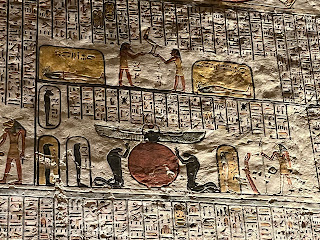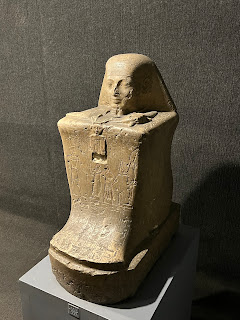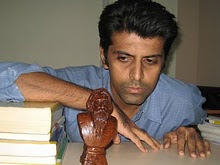Travels with Selkit - 5
OCTOBER 5th, 2024:
The day begins the same way as yesterday. Past the Memnons, I turn right and bike along the north going branch of the highway. By 7 am, I am at the gates of the Kings Valley.
Over 60 pharaohs, mostly from the second millennium BC, once lay buried here among the barren hills. Each tomb has a separate entry ticket - the average tomb can be seen for a few hundred pounds and some demand thousand and thereabouts. There is no Ramses II in the list; Tut is. I pick a few at random and enter...
---------
A remark: Mal writer Zachariah refers to these tombs with typical crassness as 'corpse holes' or 'corpse burrows'.
The tomb of Seti I must have easily been one of the grandest in its heyday (if a tomb can ever have a heyday!) - it consists of many chambers with connecting galleries and goes very deep underground; every inch of the walls and ceilings covered with richly detailed murals and ultra neat hieroglyphs. Now, despite the great majority of the murals having gotten damaged, there is still enough detail and fantastic imagery to leave a lasting impression..
One of the walls - vaguely reminiscent of a Giotto altarpiece...
Here are some really creepy fantacies...
A very long snake has grown legs and become a sort of conveyor belt for coffins... this pic shows only the head portion of the snake
It can't get much weirder than this - a snake with three heads, 4 legs and a pair of vulture wings:
A falcon perched on a double header - each head bearing a different crown.
_____
Here is the most famous tomb of them all: Tutankhaman. Fame apart, Tut's tomb is quite modest in comparison to Seti. Indeed, Tut was a rather weak and shortlived ruler.
In this pic, Osiris reaches out from within his 'mummy wrap' to embrace the king.
That is said to be Ay, Tut's successor both as king and husband to his queen, performing some ritual to Tut's mummy:
Four winged goddesses guard Tut's elegant sandstone sarcophagus. This is good old Selkit:
The tomb shared by Ramses V and VI seems the richest in the sheer number of paintings and their state of preservation:
Overarching sky goddess Nut gobbles the Sun (btw, this is the very first image of an Egyptian deity in my personal memory... long long ago, at the age of 5 or 6 I was dumbfounded by a picture in the 'Illustrated Weekly' of a huge female figure spanning the heavens and eating the sun at dusk everyday - and shitting him out at dawn (well, she actually delivers the sun)!)
The sun drifts down Nut's gut and in the heavens that we see, his barque traverses the zodiac.
Plenty of weird action in this 'juggling goddess' pic:
More weirdness, including a double headed sphinx bearing a barque:
Multiple copies of a 'man-bird' in a prayer-like pose; limp and naked humans drifting down a waterway...
The two giant hands belong to a dead person's spirit, it seems:
Lots more of weirdness... Somewhere you can see two cobras each with a pair of extra hands sprouting from its hood!
Isis and Selkit (?) about to catch a guy falling from the sky - or throwing him up in celebration (or whatever!):
At the farthest corner of the winding valley is the largely unvisited tomb of Thutmos IV. As I turn back (haven't bought the ticket), the lone guard speaks: "Fees 100 pounds. Give me!" I remember a Satyajit Ray film dialog: "thank God for corruption!"
An inscription in the Heiratic script - as ancient as hieroglyphics.
Divinities bless the pharaoh with divine life. Note the pattern on the stylish gown worn by Hathor.
Goddess Nephthys, one of the guards of the royal sarcophagus. Experts have observed how nicely her arms 'intrude' into the hieroglyphics captions.
--------
It is very hot when I leave the Kings' valley. Mercifully, the first few kilometers of the path to Hatshepsut temple is a gentle descent - in the morning, this stretch was a painful struggle, despite the weather having been a lot more benign.
Hatshepsut/Deir el Bahri (15th century BC, an antiquity equalling the Rigveda) has easily the most dramatic setting of any building I have seen - or known. Is this the first major multi-storey structure in history?
Colossal statues of the great queen (•)in 'Osiris pose' enhance the grandeur of the facade:
The interior is sadly roofless and mostly pillarless. Hathor surveys the scene from the capital of a surviving pillar:
The brightly colored murals that decorated the walls are now mostly gone. Some remnants:
That is Hapi and his copy doing the usual thing:
A kilted pharaoh runs as part of a Sed festival ritual. I am told this particular manner of representing the ruler dates back at least to the time of Zoser (27th century BC).
Adjacent to the queen's temple is the tomb of Montuemhat - Major of Thebes, prophet and governor all rolled into one. The entrance is thru a grand arch. The place is locked up.
It is well past midday and it's time to turn resort-ward. I now take a different and as per Maps, somewhat shorter path so I won't be seeing the Memnons any more....
On the way are several 'alabaster factories' named after pharaohs and this very unusual (almost certainly residential) building, its facade a heady mix of Islamic imagery and polytheism at its most idolatrous:
A view of the Nile-fed westbank fields and the bleak limestone range beyond: The mortuary temple of Seti stands within a built-up residential area:
The entire surface of the temple - pillars, ceiling, walls - were once covered by paintings; their colors have faded away almost totally:
-----
Back at the resort, I crash in an inert heap. But by 4.30, the urge to be on the move makes me venture out on the bike and cross over to the city side.
Long ago, I was pleasantly surprised and thrilled on learning that Bernini's majestic 'Four Rivers' monument featured the Ganga apart from the Nile, Danube and La Plata. Here, on the banks of the Nile, stands this fountain:
Guess it is not too farfetched to imagine the 4 jugs as representing the same 4 rivers.
Right on the riverbank is the Luxor Museum - a compact and very well presented collection of ancient Egyptian art. The first few pictures below have captions that can be read on zooming.
A 'block-statue', a rather strange and uniquely Egyptian form:
Lion-headed Goddess Sekhmet. I will be seeing more of her later on the trip:
A big trove of blue 'shabti' figurines - these used to be buried in tombs as servants for the deceased in the hereafter:
----------------
By 8.30, I take the ferry across a very black Nile and pedal back to the resort. As I progress slowly down a dim and leafy westbank bylane, a bit of unexpected and intense drama unfolds - a noise like rumbling thunder suddenly builds up behind me to great loudness. Stunned, I pull the brakes and halt sharply, narrowly managing not to hurtle down into the roadside canal. And before I can turn back and see what the hell is going on, a riderless black horse passes me at a tearing gallop and is soon lost in the distance!
The plan for tomorrow: a daytrip has been booked to two sites - Dendara and Abydos, both downstream from Luxor. No more cycling and there is a sense of loss as I hand over the bike...
--------------
(*) Once when the gods had gotten together, Ra, their king, made an announcement: "I have decided to create a girl who will become a great queen; she shall rule over Egypt and many other lands!"
Thoth, the wisest among Gods said to Ra: "My lord, I know a beautiful and virtuous woman who is in everyway suited to be the mother of the future empress - she is Ahmis, the queen of Egypt!"
Ra and other gods set out to meet Ahmis. Being gods, they could simply fly into the queen's palace. It was past midnight and Ahmis was asleep. The gods stood around making no noise; but from their divine bodies emerged a fragrance that woke the queen - she was stunned to see Ra standing before her in all his glory.
As per divine protocol, Ra wouldn't talk to those who need the support of the earth. So, some of the gods lifted the queen's cot and bore it on their shoulders. Ra now spoke, revealing to Ahmis his divine plan; he finally said: "Meet my assistant, lord Khnum. He will mould a daughter for you out of clay!"
The queen eventually bore a daughter who was named Hatshepsut. Every moment of her life was a celebration, not only for her subjects but for the gods themselves. As Ra ordained, the princess had no equal in beauty and intelligence. As empress of Egypt, she had no equal in wealth or achievement. Hatshepsut built a great temple that stands proudly to this day! (from Mali's 'Balakathamalika')






















































0 Comments:
Post a Comment
<< Home